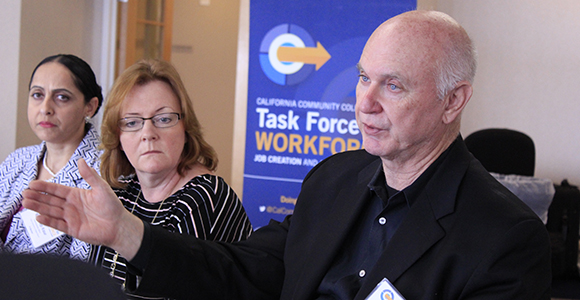
President & CEO of Mount San Antonio College Bill Scroggins (Photo Credit: John Guenther)
The promise of Career Technical Education (CTE) programs has been that students can jump into a well-paying career without having to get a four-year degree. But the peril has been the risk and cost of creating more CTE programs, often making California colleges averse to offering them, frustrating faculty who want to see the promise fulfilled.
“We feel isolated,” said Lynn Shaw, a faculty member at Long Beach City College and member of a task force formed by the Board of Governors of the California Community Colleges Chancellor’s Office to close the skills gap in California. “We feel neglected and we are so happy that this task force is happening because we finally feel like we’re getting our due.”
This week in Sacramento the task force tackled multiple topics including the challenge of becoming nimble enough to quickly adapt to industry changes and also attract qualified CTE faculty. It’s the third meeting by the group since January. The problem of creating new programs created a lot of discussion for the members who come from schools, industry and workforce development groups.
“But the new and emerging programs…it is really an unknown narrative,” said Craig Justice, vice president for instruction at Irvine Valley College. “There’s a lot of uncertainty and those who know the business model of risk and uncertainty know how treacherous and uncertain investment truly is. So that becomes a deal stopper.”
Also addressed Wednesday was the problem of getting new courses approved. Not only are CTE courses more expensive to offer because of equipment and other costs, they have extra steps other academic programs don’t have to take, like labor market analysis, advisory committee and regional consortium approval.
And that’s not just for creating new programs but changing existing ones.
“They told me it would probably be two years before I could get it into the catalog,” said Mollie Smith, director of occupational & noncredit programs at Palomar College.
The task force has been at work since January brainstorming solutions to the problem of closing the skills gap in California where it’s projected one million middle-skill workers will be needed in the next 10 years. The group will craft recommendations and present them to the College’s Board of Governors in September.
Expanded funding to offer more CTE classes is also a significant puzzle for California. Like the discussion of CTE stigma from students and parents in the last meeting, members talked about how CTE is sometimes viewed as “second-class” on campuses which doesn’t help the funding cause.
“There are colleges that look at articulation to four years as being their primary responsibility and CTE is kind of something only gets looked at, and I think it may be a funding issue more than anything else,” said Mike Dozier, executive director for the Office of Community & Economic Development at CSU Fresno.
The task force is also talking about a range of solutions beyond just more money. Researchers presented info on creating more structured career pathways that guide students through high school instruction that integrates with colleges and careers in in-demand positions. The pathways require a significant amount of coordination between colleges, K-12 school districts, employers and others in the regions, but have significant benefits, say supporters.
“Pathways are essentially a sector strategy,” said Linda Collins, executive director of the Career Ladders Project, which consults with community colleges to create career pathways. “They actually, when we work together with our employers, help us build the sector and create ongoing talent pipeline.”
Other ideas included creating “model curriculum” and common course descriptions which would work toward standardizing certificates and degrees across the colleges so students and employers know what they can expect from a program.
Another solution that came up was boosting training of career counselors in the types of CTE programs out there so they can more effectively advise students on their options.
“When I was talking to my students yesterday about why I wasn’t going to be in class today, I was trying to explain to them and none of them knew what CTE was,” said Toni Parsons, faculty member and curriculum committee chair at San Diego Mesa College.
Despite the significant challenges of turning the big ship of education to highlight the promise of CTE, there are some examples of what happens when colleges successfully collaborate with industry to fill up the worker pipeline. The California Community Colleges Chancellor Dr. Brice Harris gave the task force an example of ramping up for solar industry growth.
“We were saying ‘OK but are you really sure you’re going to be able to hire those people?’, said Harris. “So in a leap of faith, we did it and solar is catching on and there are a lot of solar technicians coming out of our colleges that are getting great jobs. There are lot of business decisions that came together.”
The Board Of Governors Task Force on Workforce, Job Creation and a Strong Economy meets up again June 11 to continue crafting proposals, wrapping up their work this summer.

